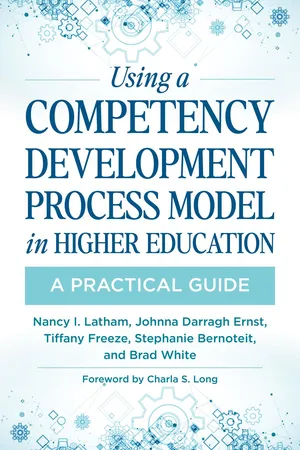
Using a Competency Development Process Model in Higher Education
A Practical Guide
- 168 pages
- English
- ePUB (mobile friendly)
- Available on iOS & Android
Using a Competency Development Process Model in Higher Education
A Practical Guide
About this book
What if educational programs designed curriculum with the end in mind, teaching and assessing only the knowledge and skills necessary for success in the workplace and broader life applications? Competency-Based Education (CBE) provides an answer to questions such as this one that key stakeholders such as employers, learners, parents, and educators are asking. In this book, the authors offer a Competency Development Process Model (CDPM) with unique features that emphasize the interdependence of competencies, assessments, and a robust learning journey within a fully developed career pathway. Two case examples are used throughout the book to contextualize the CDPM. There are seven steps of the model:
- Step 1: Define the Problem
- Step 2: Establish the CompetencyFramework
- Step 3: Draft theCompetency Statements
- Step 4: EstablishCompetency Measurability
- Step 5: Develop CompetencyAssessments
- Step 6: Adopt and ImplementCompetencies in Learning Journey and Credentialing Systems
- Step 7: Evaluate Impact OverTime
The model addresses the importance of situating competencies within a professional learning context using a backward design approach. In doing so, the model aims to elevate the work of designing competencies from merely developing a list of expectations to in-depth analysis and design, with the goal of developing competencies that can be readily used for assessment and career pathway development.
Each step in the CDPM is treated as a chapter, and each chapter identifies the central question that must be answered, provides an overview of the tasks in the step, and illustrates the steps in action through the two case examples. Each chapter concludes with "Your Turn"—guiding questions for the reader to apply the step to their own context.
Frequently asked questions
- Essential is ideal for learners and professionals who enjoy exploring a wide range of subjects. Access the Essential Library with 800,000+ trusted titles and best-sellers across business, personal growth, and the humanities. Includes unlimited reading time and Standard Read Aloud voice.
- Complete: Perfect for advanced learners and researchers needing full, unrestricted access. Unlock 1.4M+ books across hundreds of subjects, including academic and specialized titles. The Complete Plan also includes advanced features like Premium Read Aloud and Research Assistant.
Please note we cannot support devices running on iOS 13 and Android 7 or earlier. Learn more about using the app.
Information
Table of contents
- Cover
- Half-title Page
- Title Page
- Copyright
- Contents
- List of Figures and Tables
- Foreword
- Acknowledgments
- Introduction
- 1 Define the Pathway Problem
- 2 Establish the Competency Framework Analysis of Professional Expectations That Define the Field
- 3 Draft Competency Statements
- 4 Establish Competency Measurability
- 5 Develop Competency Assessments
- 6 Adopt and Implement Competencies In Learning Journey and Credentialing Systems
- 7 Evaluating the Impact of Competencies Over Time and Supporting Competency Sustainability
- Conclusion
- About the Authors
- Index
- Also available from Stylus
- Backcover